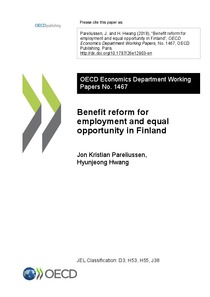Benefit reform for employment and equal opportunity in Finland
"The combination of different working-age benefits, childcare costs and income taxation creates complexity, reduces work incentives and holds back employment. Major disincentives in Finland are related to tapering rules for unemployment benefits, social assistance and the housing benefit, the e...
| Main Authors: | , |
|---|---|
| Institution: | ETUI-European Trade Union Institute |
| Format: | TEXT |
| Language: | English |
| Published: |
Paris
2018
OECD |
| Subjects: | |
| Online Access: | https://www.labourline.org/KENTIKA-19399220124911174029-Benefit-reform-for-employment-.htm |
| Summary: | "The combination of different working-age benefits, childcare costs and income taxation creates complexity, reduces work incentives and holds back employment. Major disincentives in Finland are related to tapering rules for unemployment benefits, social assistance and the housing benefit, the extended unemployment benefit for older workers, the childcare fee structure and the homecare allowance. Improved benefit design combined with efficient activation policies can reduce complexity and remove the strongest disincentives while minimising adverse fiscal and social impacts. Replacing current benefits with a basic income would improve incentives for many, but with a drastic redistribution of income and likely increasing poverty as a result. Merging working-age benefits with similar aims and coordinating their tapering against earnings would on the other hand consistently improve work incentives and transparency, while preserving social protection. Once the new income registry comes online, linking benefit payments to real-time incomes, combined with strengthened work incentives, would make for a truly efficient and inclusive benefit system, fit for the future of work. This Working Paper relates to the 2018 OECD Economic Survey of Finland (www.oecd.org/eco/surveys/economic-survey-finland.htm)." |
|---|---|
| Physical Description: | 39 p. Digital |

